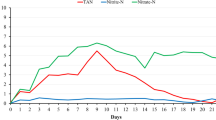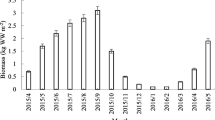Abstract
The effects of supplementation with the benthic diatom Cylindrotheca fusiformis on the growth of the sea cucumber Apostichopus japonicus and water quality was studied in six sea cucumber culturing ponds (600 m2 each) from November 2011 to November 2012. The nutrients for sea cucumbers in the control group were supplied solely by the spring tide inflow; whereas, in the experimental group, C. fusiformis diatoms were also added as feed. Total nitrogen and total phosphorus in the water in the diatom-supplemented group were not significantly different from the control group (P > 0.05). At one time point (October), the NH4-N in the diatom-supplemented group was lower than that in the control group (P < 0.05). The specific growth rate and biomass per unit area of sea cucumbers in the diatom-supplemented group were significantly higher than that in the control group in June (P < 0.05), and the biomass per unit area of sea cucumbers followed a similar trend in November (P < 0.05). Nevertheless, the advantages accumulated at the early stage were non-significant by the end of the experiment (P > 0.05). The economic benefits in the diatom-supplemented group were 10.9 % higher than that in the control group. The results suggest that fresh C. fusiformis can serve as an important food resource for sea cucumbers during the early growth stages. Therefore, supplementation with fresh C. fusiformis may be effective for increasing water quality and sea cucumber production, as C. fusiformis can provide food for aquaculture animals and utilize nitrogen and phosphorus in the water.






Similar content being viewed by others
References
Asha PS, Muthiah P (2002) Spawning and larval rearing of sea cucumber Holothuria (Theelothuria) spinifera Theel. SPC Beche-de-mer Inf Bull 16:11–15
Association of Official Analytical Chemists (AOAC) (1990) Official methods of analysis, In: Helrich K (ed) 15th edn. Association of official analytical chemists, Arlington, VA, USA
Craggs RJ, McAuley PJ, Smith VJ (1997) Wastewater nutrient removal by marine microalgae grown on a corrugated raceway. W Res 31:1701–1707
Falciatore A, Bowler C (2002) Revealing the molecular secrets of marine diatoms. Annu Rev Plant Biol 53:109–130
Fisheries Department of Agriculture Ministry of China (2011) China fisheries yearbook. China Agriculture Press, Beijing
Grasshoff K, Erhardt M, Kreling K (1985) Methods of seawater analysis, 2nd edn. Verlag Chemic, Weinlim, pp 171–198
Hamel JF, Mercier A (1996) Early development, settlement, growth, and spatial distribution of the sea cucumber Cucumaria frondosa (Echinodermata: Holothuroidea). Can J Fish Aquat Sci 53:253–271
Helena K, Fatimah MY, Sanjoy B, Ohamed S, Suhaila M (2007) Use of periphytic cyanobacterium and mixed diatoms coated substrate for improving water quality, survival and growth of Penaeus monodon Fabricius postlarvae. Aquaculture 271:196–205
Ito S, Kitamura H (1997) Induction of larval metamorphosis in the sea cucumber Stichopus japonicus by periphitic diatoms. Hydrobiologia 358:281–284
Kawamura T, Takami H (1995) Analysis of feeding and growth rate of newly metamorphosed abalone Haliotis discus hannai fed on four species of benthic diatom. Fish Sci 61:357–358
Kawamura T, Roberts RD, Nicholson CM (1998) Factors affecting the food value of diatom strains for post-larval abalone Haliotis iris. Aquaculture 160:81–88
Lan L, Wang QH, He Y, Liu Y, Gong QL (2012) Analysis of nutritional components of Cylindrotheca fusiformis under fed-batch-continuous culture. J Ocean university China 42:68–71 (in Chinese)
Lefebvre S, Hussenot J, Brossard N (1996) Water treatment of land-based fish farm effluents by outdoor culture of marine diatoms. Appl Phycol 8:193–200
Li JW (2013) Studies on the carbon, nitrogen, phosphorus budgets in the integrated aquaculture of sea cucumber Apostichopus japonicas-jellyfish Rhopilema esculenta-shrimp Fenneropenaeus chinensis and sea cucumber monoculture fed with benthic diatom Cylindrotheca fusiformis. Doctor dissertation of Ocean University of China 41-42 (in Chinese with English abstract)
Li JW, Dong SL, Gao QF, Zhu CB (2014) Nitrogen and phosphorus budget of integrated aquaculture system of sea cucumber Apostichopus japonicus, jellyfish Rhopilema esculenta and shrimp Fenneropenaeus chinensis. J Ocean Univ China 13:503–508
Liu Y, Dong SL, Tian XL, Wang F, Gao QF (2010) The effect of different macroalgae on the growth of sea cucumbers (Apostichopus japonicus Selenka). Aquac Res 2:1–5
Mantoura RFC, Woodward EMS (1983) Optimization of the indophenol blue method for the automated determination of ammonia in estuarine waters. Estuar Coast Shelf Sci 17:219–224
Murphy J, Riley JP (1962) A modified single solution method for determination of phosphate in natural waters. Anal Chimi Acta 27:31–36
National standardization management council (2007) Specifications for oceanographic survey, GB/T 12763.6. Mar Biol Surv 6:6–7
Qiu FL, Zou N, Wang HN, Wang YY (2007) Effect of freshwater benthic diatom on seacucumber. Life Sci Instrum 10:16–18
Ramofafia C, Gervis MG, Bell J (1995) Spawning and early larval rearing of Holothuria atra. SPC Beche-de-mer Inf Bull 7:2–6
Ren YC, Dong SL, Qin CX, Wang F, Tian XL, Gao QF (2012) Ecological effects of co-culturing sea cucumber Apostichopus japonicus (Selenka) with scallop Chlamys farreri in earthen ponds. Chin J Oceanol Limnol 30:71–79
Ruben E, Avendano H, Carlos ER (2007) Production of a diatom-bacteria biofilm in a photobioreactor for aquaculture applications. Aquac Eng 36:97–104
Seki T, Kan-No H (1981) Observations on the settlement and metamorphosis of the veliger of the Japanese abalone, Haliotis discus hannai, Ino, Haliotidae, Gastropoda. Bull Tohoku Reg Fish Res Lab 42:31–39
Shi C, Dong SL, Pei SR, Wang F, Tian XL, Gao QF (2013) Effects of diatom concentration in prepared feeds on growth and energy budget of the sea cucumber Apostichopus japonicus (Selenka). Aquac Res. doi:10.1111/are.12206
Thompson FL, Abreu PC, Wasielesky W (2002) Importance of biofilm for water quality and nourishment in intensive shrimp culture. Aquaculture 203:263–278
Tomita K, Tazawa N (1971) On the stomach contents of young abalone, Haliotis discus hannai Ino, in Rebun Island, Hokkaido (in Japanese with English abstract). Sci Rep Hokkaido Fish Exp Sm 13:31–38
Yuan CY (2005) Current status and development of feed in sea cucumber. Fish Sci 24:54–56 (in Chinese)
Zhang CY, Wang YG, Rong XJ, Sun HL, Dong SG (2004) Natural resources, culture and problems of sea cucumber worldwide. Mar fish res 25:89–97
Zhang LB, Gao Y, Zhang T, Yang HS, Xu Q, Sun LN, Yu ZH (2014) A new system for bottom co-culture of the scallop, Patinopecten yessoensis, with the sea cucumber, Apostichopus japonicus, and the sea urchin, Anthocidaris crassispina, in shallow water in China. Aquac Int. doi:10.1007/s10499-014-9755-9
Zhao YM, Tian XL (2011) Effects of species composition of benthic diatoms on growth and survival of postlarval and juvenile abalone Haliotis discus hannai. Fish Sci 30:144–147
Acknowledgments
This work was supported by the National Key R & D Program (2011BAD13B03) and National Marine Public Welfare Project of China (200905020).
Author information
Authors and Affiliations
Corresponding author
Rights and permissions
About this article
Cite this article
Li, J., Dong, S., Tian, X. et al. Effects of the diatom Cylindrotheca fusiformis on the growth of the sea cucumber Apostichopus japonicus and water quality in ponds. Aquacult Int 23, 955–965 (2015). https://doi.org/10.1007/s10499-014-9854-7
Received:
Accepted:
Published:
Issue Date:
DOI: https://doi.org/10.1007/s10499-014-9854-7




